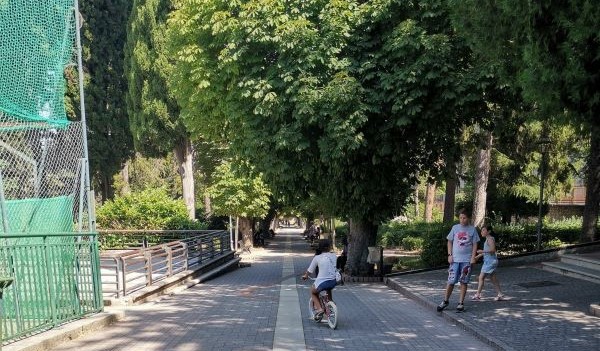
La villa di Santa Maria risale ai primi decenni dell’Ottocento e prende il nome dal rione omonimo. Negli anni passati nel sito del Rione esisteva solo il convento dei Padri Francescani Riformati, con l’annessa Chiesa e con l’orto dei monaci.
Quest’ultimo, secondo un documento del 1883, venne ceduto al Demanio e, in seguito, divenne un orto agrario dall’elevato livello scientifico.
L’orto cominciò a essere chiamato “villa” tra il 1878 e il 1885 a seguito dei numerosi interventi di riqualificazione grazie all’impegno delle Amministrazioni pubbliche. Nei pressi dell’attuale ingresso laterale, a ridosso del muro esterno, venne impiantata una piccola fontana, dotata di un abbeveratoio e diunlavatoio.
La creazione del Quartiere Militare Basilicata rese necessario un secondo ingresso al centro del lato sud, di fronte al portone della Caserma, tuttora esistente.
Negli anni successivi la villa continuò a essere oggetto di cure, Nel 1923, su richiesta degli Ufficiali del 29° Reggimento di Fanteria, venne ampliato il lato nord-ovest della villa per la realizzazione di un campo da tennis e di una pista per il pattinaggio.
Negli anni trenta venne realizzato il Parco della Rimembranza denominato “Parco dei caduti fascisti” che vide l’apposizione su novantadue alberi di altrettante targhe con i nomi dei caduti potentini della prima guerra mondiale. In quella occasione vennero anche allestite due tribune per accogliere le autorità. Nel 1938 venne impiantata una serra per le colture floreali e in seguito un campo per il gioco delle bocce. Negli ultimi anni del novecento è stata rifatta la pavimentazione, messa in funzione la grande fontana all’ingresso principale e data maggiore cura a alberi e aiuole.
Orario di apertura (ordinanza n. 57/2023):
dal 01.05 al 30.09 dalle ore 07,30 alle ore 23,00;
dal 01.10 al 30.04 dalle ore 07,30 alle ore 21,30.
Tutti i giorni, festivi compresi.
The villa of Santa Maria dates back to the first decades of the nineteenth century and takes its name from the district where it’s located. In past years, only the convent of the Reformed Franciscan Fathers existed in the district, with the adjoining church and the garden of the monks. The latter, according to a document of 1883, was ceded to the state property, and later became an agricultural garden of high scientific level. The garden began to be called “villa” between 1878 and 1885, following the numerous redevelopment interventions.
Near the current side entrance, close to the external wall, a small fountain was planted, equipped with a drinking trough and a wash-basin. The creation of the Basilicata Military District made a second entrance necessary in the center of the south side, in front of the barrack’s door, still existing.
In 1923, at the request of the officers of the 29th Infantry Regiment, the north-west side of the villa was enlarged to build a tennis court and a skating rink. In the 1930’s the Park of Remembrance was created, being called the “Fascist Fallen Park”, which saw the affixing on ninety-two trees with the names of the fallen soldiers of the WW1.
On that occasion, two stands were also set up to welcome the authorities. In 1938 a greenhouse was planted for floral crops, and later a field for the game of bowls. In the last years of the twentieth century the floor was restored, the large fountain at the main entrance was put into operations and more attention was given to trees and flower beds.
Testo e foto a cura dei volontari del progetto di Servizio Civile “………… c’è TURISMO e CULTURA a POTENZA”
FONTI:
Basilicata Turistica
talentilucani.it

















